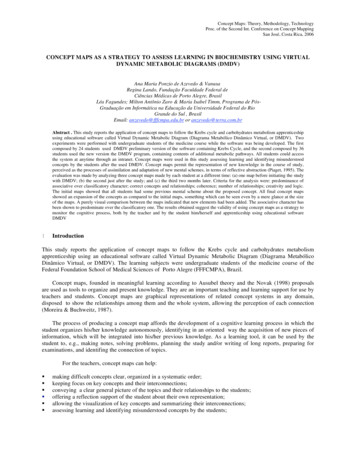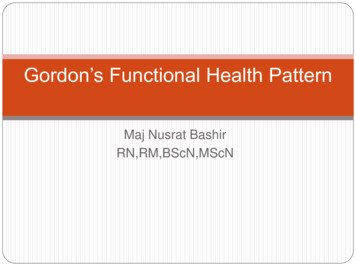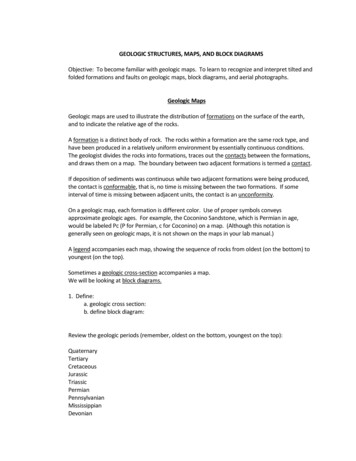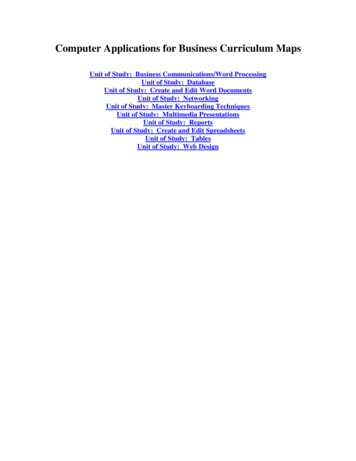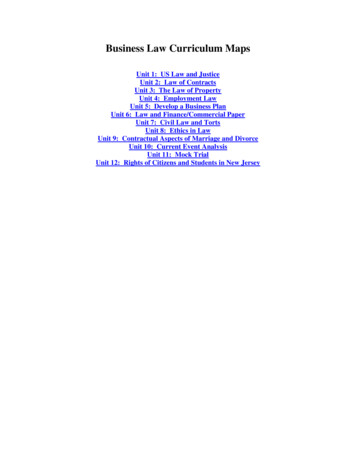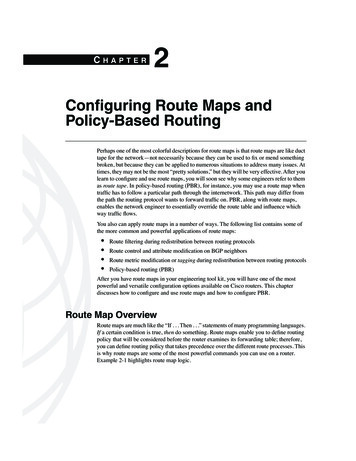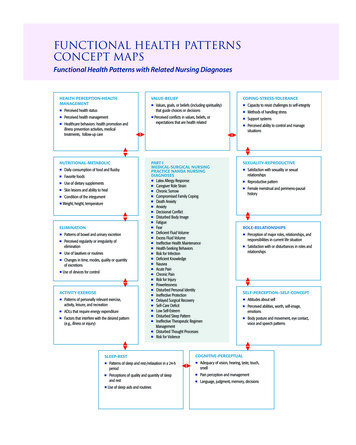
Transcription
koz74686 INSERT.qxd11/15/065:15 PMPage 1Functional Health patternsConcept mapsFunctional Health Patterns with Related Nursing Diagnoses
koz74686 INSERT.qxd11/15/065:15 PMPage 2Nutrition and Metabolic Patterns with Related Nursing DiagnosesCOPING-STRESS-TOLERANCEVALUE-BELIEFHEALTH PERCEPTION-HEALTHMANAGEMENT Perceived health status Perceived health management Healthcare behaviors: health promotion andillness prevention activities, medicaltreatments, follow-up carePerceived conflicts in values, beliefs, orexpectations that are health related Capacity to resist challenges to self-integrity Methods of handling stress Support systems Perceived ability to control and managesituations䉱䉲䉱䉲 Values, goals, or beliefs (including spirituality)that guide choices or decisions䉱䉲䉱䉲NUTRITIONAL-METABOLIC Daily consumption of food and fluidsy Favorite foods Use of dietary supplements Skin lesions and ability to heal Condition of the integument Weight, height, temperature䉱䉲ELIMINATION Patterns of bowel and urinary excretion Perceived regularity or irregularity ofelimination Use of laxatives or routines Changes in time, modes, quality or quantityof excretions Use of devices for control䉱䉲ACTIVITY-EXERCISEPatterns of personally relevant exercise,activity, leisure, and recreation ADLs that require energy expenditure Factors that interfere with the desired pattern(e.g., illness or injury)䉱䉲SLEEP-REST Patterns of sleep and rest-/relaxation in a 24-hperiod Perceptions of quality and quantity of sleepand rest Use of sleep aids and routinesSEXUALITY-REPRODUCTIVE Satisfaction with sexuality or sexualrelationships Reproductive pattern Female menstrual and perimeno-pausalhistory䉱䉲ROLE-RELATIONSHIPS Perception of major roles, relationships, andresponsibilities in current life situation Satisfaction with or disturbances in roles PT Attitudes about self Perceived abilities, worth, self-image,emotions Body posture and movement, eye contact,voice and speech patterns䉱䉲COGNITIVE-PERCEPTUAL䉱䉲 PART IINUTRITIONAL METABOLICPATTERNS NANDA NURSINGDIAGNOSES Risk for Aspiration Risk for Imbalanced Body Temperature Impaired Dentition Feeding Self-Care Deficit Deficient Fluid Volume Fluid Volume Excess Risk for Deficient Fluid Volume Hyperthermia Hypothermia Risk for Infection Impaired Oral Mucous Membranes Nausea Imbalanced Nutrition: Less than BodyRequirements Imbalanced Nutrition: More than BodyRequirements Impaired Skin Integrity Risk for Impaired Skin Integrity Impaired Swallowing Ineffective Thermoregulation Impaired Tissue Integrity Risk for Trauma Adult Failure to Thrive Adequacy of vision, hearing, taste, touch,smell Pain perception and management Language, judgment, memory, decisions
koz74686 INSERT.qxd11/15/065:15 PMPage 3Elimination Patterns with Related Nursing DiagnosesCOPING-STRESS-TOLERANCEVALUE-BELIEFHEALTH PERCEPTION-HEALTHMANAGEMENT Perceived health status Perceived health management Healthcare behaviors: health promotion andillness prevention activities, medicaltreatments, follow-up carePerceived conflicts in values, beliefs, orexpectations that are health related Capacity to resist challenges to self-integrity Methods of handling stress Support systems Perceived ability to control and managesituations䉱䉲䉱䉲 Values, goals, or beliefs (including spirituality)that guide choices or decisions䉱䉲䉱䉲NUTRITIONAL-METABOLIC Daily consumption of food and fluidsy Favorite foods Use of dietary supplements Skin lesions and ability to heal Condition of the integument Weight, height, temperature䉱䉲ELIMINATION Patterns of bowel and urinary excretion Perceived regularity or irregularity ofelimination Use of laxatives or routines Changes in time, modes, quality or quantityof excretions Use of devices for controlPART IIIELIMINATION PATTERNSNANDA NURSING DIAGNOSES Bowel Incontinence Constipation Perceived Constipation Risk for Constipation Diarrhea Impaired Urinary Elimination Functional Urinary Incontinence Reflex Urinary Incontinence Stress Urinary Incontinence Total Urinary Incontinence Urge Urinary Incontinence Risk for Urge Urinary Incontinence Urinary Retention Toileting: Self-Care DeficitSEXUALITY-REPRODUCTIVE Satisfaction with sexuality or sexualrelationships Reproductive pattern Female menstrual and perimeno-pausalhistory䉱䉲ROLE-RELATIONSHIPS Perception of major roles, relationships, andresponsibilities in current life situation Satisfaction with or disturbances in roles PERCEPTION–SELF-CONCEPTPatterns of personally relevant exercise,activity, leisure, and recreation ADLs that require energy expenditure Factors that interfere with the desired pattern(e.g., illness or injury)䉱䉲SLEEP-REST Patterns of sleep and rest-/relaxation in a 24-hperiod Perceptions of quality and quantity of sleepand rest Use of sleep aids and routines Attitudes about self Perceived abilities, worth, self-image,emotions Body posture and movement, eye contact,voice and speech patterns䉱䉲COGNITIVE-PERCEPTUAL䉱䉲 Adequacy of vision, hearing, taste, touch,smell Pain perception and management Language, judgment, memory, decisions
koz74686 INSERT.qxd11/15/065:15 PMPage 4Activity and Exercise Patterns with Related Nursing DiagnosesVALUE-BELIEFHEALTH PERCEPTION-HEALTHMANAGEMENT Perceived health status Perceived health management Healthcare behaviors: health promotion andillness prevention activities, medicaltreatments, follow-up careValues, goals, or beliefs (including spirituality)that guide choices or decisionsPerceived conflicts in values, beliefs, orexpectations that are health related Capacity to resist challenges to self-integrity Methods of handling stress Support systems Perceived ability to control and managesituations䉱䉲䉱䉲 ABOLIC Daily consumption of food and fluids Favorite foods Use of dietary supplements Skin lesions and ability to heal Condition of the integument Weight, height, temperature䉱䉲ELIMINATION Patterns of bowel and urinary excretion Perceived regularity or irregularity ofelimination Use of laxatives or routines Changes in time, modes, quality or quantityof excretions Use of devices for control䉱䉲ACTIVITY-EXERCISEPatterns of personally relevant exercise,activity, leisure, and recreation ADLs that require energy expenditure Factors that interfere with the desired pattern(e.g., illness or injury)䉱䉲SLEEP-REST Patterns of sleep and rest-/relaxation in a 24-hperiod Perceptions of quality and quantity of sleepand rest Use of sleep aids and routinesSEXUALITY-REPRODUCTIVE Satisfaction with sexuality or sexualrelationships Reproductive pattern Female menstrual and perimeno-pausalhistory䉱䉲ROLE-RELATIONSHIPS Perception of major roles, relationships, andresponsibilities in current life situation Satisfaction with or disturbances in roles PT Attitudes about self Perceived abilities, worth, self-image,emotions Body posture and movement, eye contact,voice and speech patterns䉱䉲COGNITIVE-PERCEPTUAL䉱䉲 PART IVACTIVITY-EXERCISE PATTERNSNANDA NURSING DIAGNOSES Activity Intolerance Risk for Activity Intolerance Bathing/Hygiene Self-Care Deficit Dressing/Grooming Self-Care Deficit Impaired Bed Mobility Risk for Disuse Syndrome Deficient Diversional Activity Fatigue Risk for Falls Impaired Home Maintenance Impaired Physical Mobility Impaired Wheelchair Mobility Impaired Transfer Ability Impaired Walking Delayed Surgical Recovery Decreased Cardiac Output Ineffective Breathing Pattern Ineffective Airway Clearance Impaired Gas Exchange Risk for Peripheral Neurovascular Dysfunction Impaired Tissue Integrity Ineffective Tissue Perfusion Impaired Spontaneous Ventilation Dysfunctional Ventilatory Weaning Response Adequacy of vision, hearing, taste, touch,smell Pain perception and management Language, judgment, memory, decisions
koz74686 INSERT.qxd11/15/065:15 PMPage 5Cognitive Perceptual Patterns with Related Nursing DiagnosesCOPING-STRESS-TOLERANCEVALUE-BELIEFHEALTH PERCEPTION-HEALTHMANAGEMENT Perceived health status Perceived health management Healthcare behaviors: health promotion andillness prevention activities, medicaltreatments, follow-up carePerceived conflicts in values, beliefs, orexpectations that are health related Capacity to resist challenges to self-integrity Methods of handling stress Support systems Perceived ability to control and managesituations䉱䉲䉱䉲 Values, goals, or beliefs (including spirituality)that guide choices or decisions䉱䉲䉱䉲NUTRITIONAL-METABOLIC Daily consumption of food and fluids Favorite foods Use of dietary supplements Skin lesions and ability to heal Condition of the integument Weight, height, temperature䉱䉲ELIMINATION Patterns of bowel and urinary excretion Perceived regularity or irregularity ofelimination Use of laxatives or routines Changes in time, modes, quality or quantityof excretions Use of devices for controlPART VCOGNITIVE-PERCEPTUAL PATTERNSNANDA NURSING DIAGNOSES Acute Confusion Decreased Intracranial Adaptive Capacity Autonomic Dysreflexia Risk for Autonomic Dysreflexia Chronic Confusion Impaired Verbal Communication Acute Pain Chronic Pain Impaired Memory Unilateral Neglect Risk for Peripheral Neurovascular Dysfunction Risk for Post-Trauma Syndrome Ineffective Protection Disturbed Sensory Perception Disturbed Thought Processes Decisional Conflict Risk for Trauma Wandering Impaired Environmental InterpretationSyndromeSEXUALITY-REPRODUCTIVE Satisfaction with sexuality or sexualrelationships Reproductive pattern Female menstrual and perimeno-pausalhistory䉱䉲ROLE-RELATIONSHIPS Perception of major roles, relationships, andresponsibilities in current life situation Satisfaction with or disturbances in roles PERCEPTION–SELF-CONCEPTPatterns of personally relevant exercise,activity, leisure, and recreation ADLs that require energy expenditure Factors that interfere with the desired pattern(e.g., illness or injury)䉱䉲SLEEP-REST Patterns of sleep and rest-/relaxation in a 24-hperiod Perceptions of quality and quantity of sleepand rest Use of sleep aids and routines Attitudes about self Perceived abilities, worth, self-image,emotions Body posture and movement, eye contact,voice and speech patterns䉱䉲COGNITIVE-PERCEPTUAL䉱䉲 Adequacy of vision, hearing, taste, touch,smell Pain perception and management Language, judgment, memory, decisions
koz74686 INSERT.qxd11/15/065:15 PMPage 6Sexuality-Reproductive Patterns with Related Nursing DiagnosesCOPING-STRESS-TOLERANCEVALUE-BELIEFHEALTH PERCEPTION-HEALTHMANAGEMENT Perceived health status Perceived health management Healthcare behaviors: health promotion andillness prevention activities, medicaltreatments, follow-up carePerceived conflicts in values, beliefs, orexpectations that are health related Capacity to resist challenges to self-integrity Methods of handling stress Support systems Perceived ability to control and managesituations䉱䉲䉱䉲 Values, goals, or beliefs (including spirituality)that guide choices or decisions䉱䉲䉱䉲PART VISEXUALITY-REPRODUCTIVEPATTERNS NANDA NURSINGDIAGNOSES Rape-Trauma Syndrome Sexual Dysfunction Ineffective Sexuality PatternsNUTRITIONAL-METABOLIC Daily consumption of food and fluids Favorite foods Use of dietary supplements Skin lesions and ability to heal Condition of the integument Weight, height, temperatureSEXUALITY-REPRODUCTIVE Satisfaction with sexuality or sexualrelationships Reproductive pattern Female menstrual and RELATIONSHIPS Patterns of bowel and urinary excretion Perceived regularity or irregularity ofeliminationPerception of major roles, relationships, andresponsibilities in current life situation Use of laxatives or routinesSatisfaction with or disturbances in roles andrelationships Changes in time, modes, quality or quantityof excretions Use of devices for control䉱䉲䉱䉲ACTIVITY-EXERCISE SELF-PERCEPTION–SELF-CONCEPTPatterns of personally relevant exercise,activity, leisure, and recreation ADLs that require energy expenditure Factors that interfere with the desired pattern(e.g., illness or injury)䉱䉲 Perceptions of quality and quantity of sleepand rest Perceived abilities, worth, self-image,emotions Body posture and movement, eye contact,voice and speech patternsCOGNITIVE-PERCEPTUAL䉱䉲Patterns of sleep and rest-/relaxation in a 24-hperiodAttitudes about self䉱䉲SLEEP-REST Adequacy of vision, hearing, taste, touch,smell Pain perception and management Language, judgment, memory, decisionsUse of sleep aids and routinesReprinted from Nursing Diagnosis: Process and Application, 3rd ed., by M. Gordon, pp. 80–96, Copyright 1994, with permission from Elsevier Science.
Factors that interfere with the desired pattern (e.g., illness or injury) SLEEP-REST Patterns of sleep and rest-/relaxation in a 24-h period Perceptions of quality and quantity of sleep and rest Use of sleep aids and routines COGNITIVE-PERCEPTUAL Adequacy of vision, hearing, taste, touch, smell Pain perception and management


